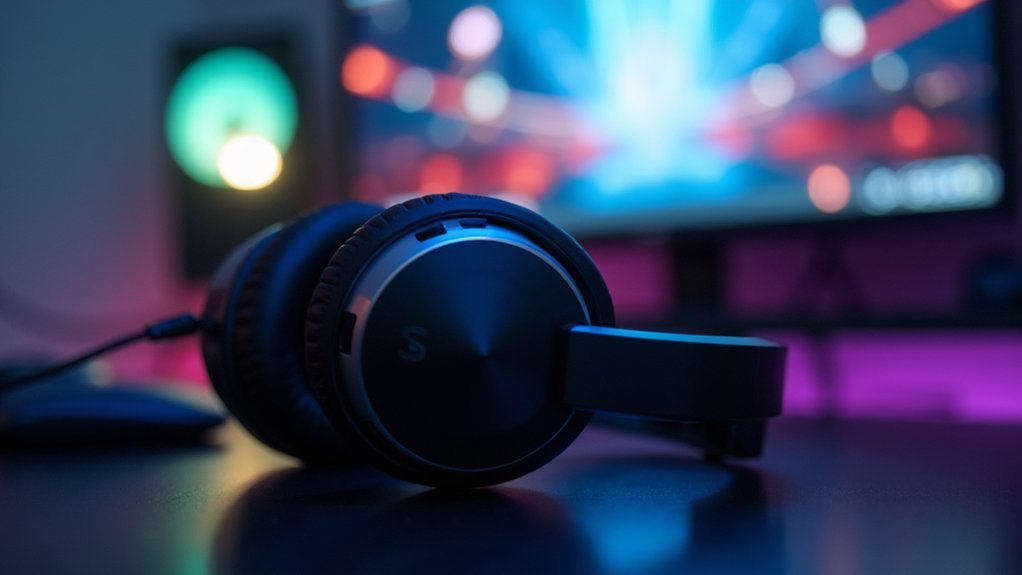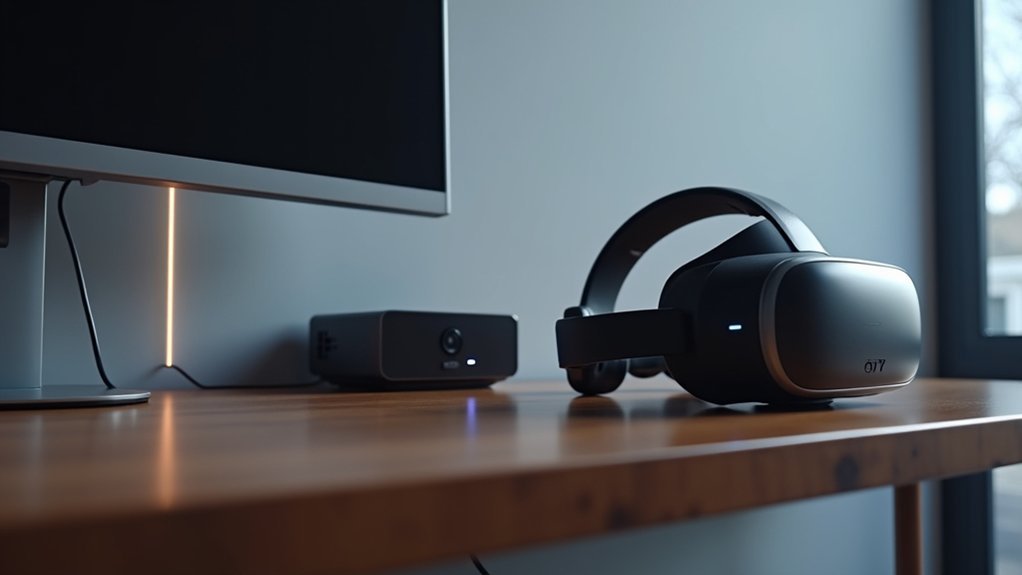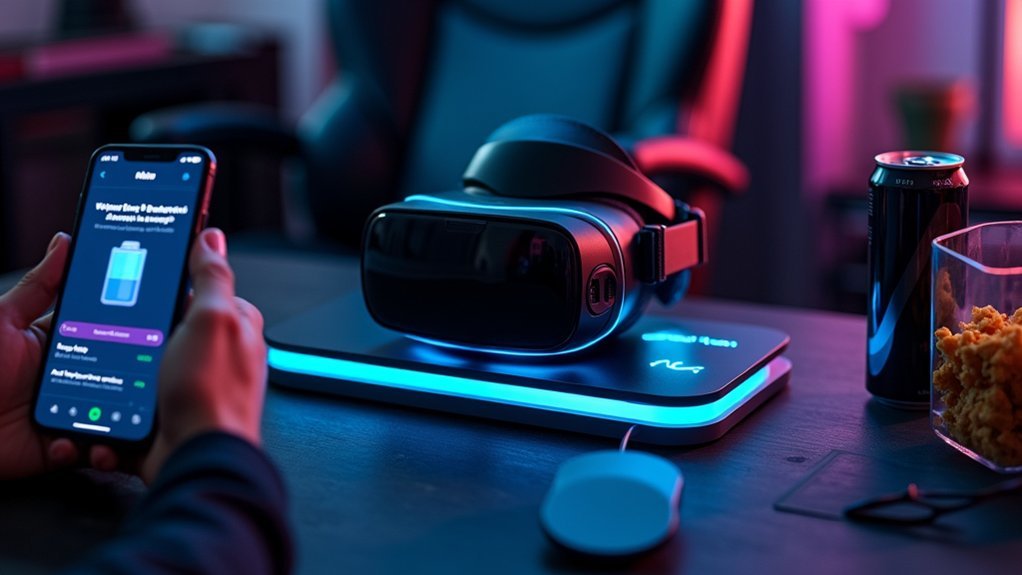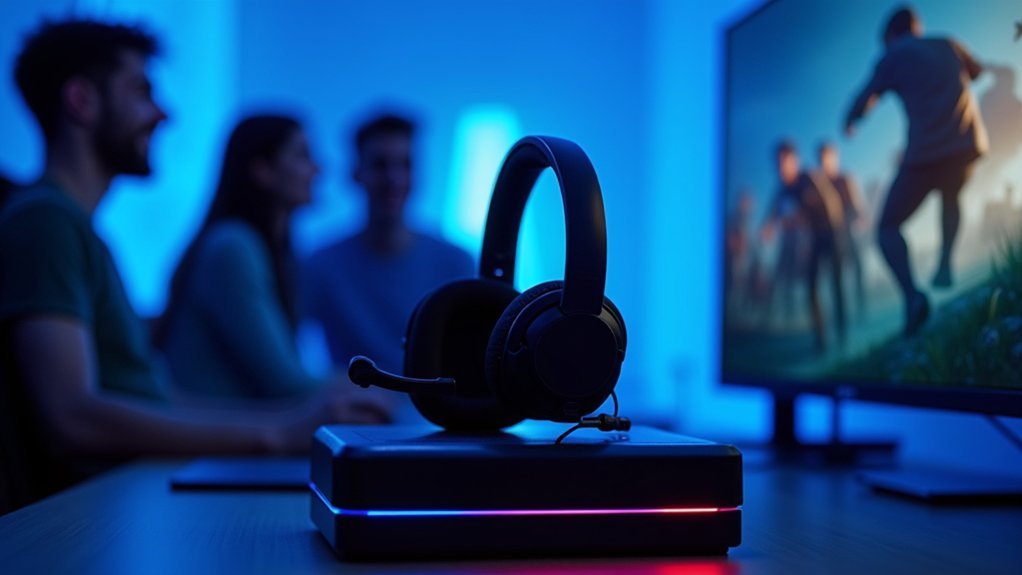You’ll excel at social wireless gaming by choosing 2.4GHz low-latency headsets for real-time communication, optimizing audio settings with cardioid microphone patterns, and maintaining clear base station line-of-sight for VR setups. Configure spatial audio for enhanced social presence, manage battery life with quick-charge models, and establish backup communication protocols through Discord or TeamSpeak. Create custom sound profiles for different game genres, synchronize audio across team members, and keep firmware updated for reliable connections. These foundational strategies will enable advanced techniques for seamless multiplayer coordination.
Choose Low-Latency Wireless Technology for Real-Time Communication

When you’re coordinating strategies with teammates during intense gaming sessions, choosing a wireless headset with low-latency technology becomes essential for maintaining real-time communication.
Low-latency wireless technology, particularly 2.4GHz connections, dramatically reduces audio delay that could compromise your competitive gaming performance.
You’ll want wireless headsets like the Razer Blackshark V2 Pro that offer dual connectivity options, enabling seamless switching between low-latency and Bluetooth modes.
RF technology typically delivers superior responsiveness compared to standard Bluetooth connections, minimizing lag during critical moments.
This investment directly impacts your team’s success in multiplayer environments where split-second decisions matter.
When communication flows without delay, you’ll coordinate more effectively, react faster to threats, and execute strategies with precision that gives your team the competitive edge.
Optimize Audio Settings for Team-Based Multiplayer Games
Beyond selecting the right wireless technology, you’ll need to fine-tune your headset’s audio settings to maximize communication effectiveness in team-based multiplayer environments.
Start by configuring your microphone quality settings to cardioid or supercardioid patterns, which reduce background noise while enhancing voice clarity for superior team communications.
Next, optimize audio through your headset’s equalizer by boosting voice frequencies, guaranteeing teammates remain audible despite intense sound effects and background music.
Don’t overlook essential headset features like firmware updates, which resolve audio bugs and improve overall performance.
Your wireless connection stability directly impacts communication quality, so test these audio settings with your team before critical matches.
This proactive approach guarantees everyone hears clearly and can make real-time adjustments for seamless coordination.
Maintain Clear Line of Sight Between Headset and VR Base Station

Since wireless VR headsets depend on unobstructed communication with base stations, you’ll need to strategically position your setup to maintain ideal signal transmission throughout your gaming sessions.
Keep a clear line of sight between your wireless headset and base station by removing furniture, walls, or objects that block the signal path. Position your base station at elevated heights to improve tracking accuracy and minimize interference.
Elevate your base station and eliminate obstructions between headset and tracker for optimal wireless VR signal transmission and tracking performance.
You’ll experience better signal stability when you dedicate a specific wireless channel for your headset, reducing conflicts with other wireless devices nearby.
Don’t forget to install firmware updates regularly on both your headset and base station, as these updates enhance performance and connection reliability during multiplayer gaming.
Configure Spatial Audio for Enhanced Social Presence
Your wireless gaming setup’s physical positioning works hand-in-hand with proper audio configuration to maximize your social gaming experience.
Configure spatial audio through your headset’s software or system settings to create three-dimensional soundscapes that deliver enhanced immersion. This technology positions audio cues accurately around you, making teammate callouts and environmental sounds more precise.
Update your headset drivers regularly to access the latest spatial audio improvements.
Test different profiles for various game genres – use environmental audio enhancement for RPGs and precise directional audio for competitive FPS games.
Popular gaming headsets like the Razer Blackshark V2 Pro offer advanced spatial audio capabilities that give you tactical advantages in multiplayer scenarios, helping you locate enemies and coordinate better with teammates.
Manage Battery Life During Extended VR Gaming Sessions

Extended VR gaming sessions demand careful battery management to prevent frustrating interruptions during critical multiplayer moments.
Your wireless headset’s battery life directly impacts your gaming experience, so smart planning is essential.
Here are four strategies to maximize your headset’s performance during extended gaming sessions:
- Choose long-lasting models – Select headsets like the Audeze Maxwell, offering 80+ hours of battery life for uninterrupted gameplay.
- Monitor and pre-charge – Check battery levels regularly and charge your headset before gaming to avoid mid-session power loss.
- Enable power-saving features – Activate automatic sleep mode during breaks to conserve energy and extend usage time.
- Consider swappable batteries – Invest in headsets with quick-charge capabilities or swappable batteries for minimal downtime and seamless charging exchanges.
Minimize Wireless Interference From Multiple VR Devices
When multiple VR devices compete for the same wireless frequencies, your gaming headset’s audio can suffer from choppy connections, static, and frustrating dropouts that disrupt your immersive experience.
Your wireless headset should operate on a dedicated 2.4GHz frequency to minimize interference from competing VR devices. Keep at least 3 feet between your headset’s receiver and other wireless equipment.
Use a USB extension cable to position the receiver closer to your headset while distancing it from routers and electronic devices. Install firmware updates regularly, as manufacturers release improvements for connectivity and interference reduction.
Switch your VR devices and headset to different channels within the 2.4GHz band to reduce overlap in signal transmission.
Adjust Microphone Settings for Clear Voice Chat
Clear audio transmission through your wireless headset requires proper microphone configuration to maximize communication effectiveness with your gaming team.
Your gaming headset’s microphone sensitivity settings directly impact how teammates hear you during voice chat sessions.
- Enhance microphone sensitivity settings in your gaming software to eliminate background noise while maintaining clear communication with your team.
- Activate noise-cancellation features on your headset to suppress unwanted ambient sounds that interfere with voice chat quality.
- Test microphone settings regularly in game lobbies before sessions to ascertain your voice transmits clearly to teammates.
- Position your adjustable headbands correctly so the microphone stays close to your mouth for consistent audio pickup and peak performance.
These adjustments guarantee superior voice chat quality during competitive gaming sessions.
Synchronize Audio Across Multiple Players in Shared Virtual Spaces
Although individual microphone settings guarantee clear voice transmission, synchronizing audio across multiple players in shared virtual spaces requires coordinated technical configuration to create seamless group experiences. You’ll need to connect all headsets to a common low-latency wireless protocol like 2.4GHz to minimize audio lag.
| Configuration Step | Action Required |
|---|---|
| Wireless Protocol | Connect all headsets to same 2.4GHz network |
| Audio Sharing | Enable group session features in software |
| Audio Settings | Match output levels across all devices |
| Virtual Rooms | Utilize platform’s shared audio environments |
| Sound Synchronization | Test and calibrate before gameplay starts |
These steps guarantee your communal gaming experience maintains perfect audio alignment, preventing the frustration of delayed or mismatched sound that can break immersion.
Customize Sound Profiles for Different VR Game Genres
You’ll dramatically improve your VR gaming experience by creating custom sound profiles tailored to specific genres, whether you’re boosting bass for intense action sequences or enhancing ambient details for exploration games.
Modern wireless headsets like the Audeze Maxwell offer sophisticated EQ settings that let you optimize VR spatial audio for each game type, making footsteps clearer in competitive shooters or environmental sounds more immersive in adventure titles.
Setting up dynamic profile switching through manufacturer software means you can instantly adapt your audio settings as you move between different VR experiences without interrupting your gameplay flow.
Genre-Specific Audio Settings
When you’re diving into different VR game genres, tailoring your audio settings makes the difference between good gameplay and truly immersive experiences.
Your wireless headset’s customizable EQ settings shouldn’t remain static across all games.
Here’s how to optimize your sound profiles for maximum impact:
- First-Person Shooters – Boost bass frequencies for impactful gunfire while enhancing directional audio accuracy to pinpoint enemy footsteps and movements for competitive advantage.
- Role-Playing Games – Prioritize clear dialogue and balanced mid-range frequencies to catch every story detail while maintaining atmospheric soundscapes.
- Exploration Games – Enable surround sound settings to create realistic 3D audio environments that make virtual worlds feel authentically lifelike.
- Regular Updates – Adjust your audio profiles after game updates since developers often modify sound design elements.
VR Spatial Sound Optimization
Since VR environments rely heavily on three-dimensional audio cues, optimizing your spatial sound settings becomes essential for maintaining immersion and tactical awareness.
Customize sound profiles in your wireless gaming headsets to enhance spatial awareness, allowing precise sound location identification vital for first-person shooters and survival horror games.
Take advantage of 3D audio support found in VR headsets to create realistic soundscapes that improve depth perception and directionality within spatial audio settings.
Use adjustable EQ settings to tailor sound quality for different genres—optimize bass for action games while enhancing mid and high frequencies for RPGs.
High-end models like the Audeze Maxwell offer customizable sound profiles for immersive experiences across diverse VR environments.
Experiment with various configurations to balance environmental sounds, dialogue, and effects perfectly for your gameplay style.
Dynamic Profile Switching
While gaming across different VR genres demands distinct audio approaches, dynamic profile switching empowers you to instantly adapt your headset’s sound signature for peak performance.
You’ll customize sound profiles that enhance your immersive experience by adjusting bass, treble, and surround sound settings according to each game type.
Here’s how to maximize this feature:
- Create FPS-focused profiles that emphasize directional audio cues, boosting your spatial awareness and reaction times during competitive matches.
- Develop RPG profiles with enhanced atmospheric sounds and dialogue clarity for story-driven adventures.
- Use headset software like Audeze Maxwell’s tools to quickly switch between multiple audio settings.
- Fine-tune profiles based on your preferences to achieve the most enjoyable gaming experience across all VR genres.
Establish Backup Communication Protocols for Connection Issues
When your wireless headset loses connection mid-game, you’ll need backup communication methods ready to keep your team coordinated.
Set up alternative platforms like Discord on your phone or enable in-game chat features before you start playing.
Practice switching between these backup options quickly so you can reconnect with teammates within seconds of losing your primary headset connection.
Alternative Communication Platforms
Although wireless gaming headsets offer excellent mobility and convenience, they’re susceptible to connection drops, battery failures, and interference that can disrupt team communication at critical moments.
You’ll need reliable alternative communication platforms to maintain seamless coordination with your team.
Here are four essential backup communication strategies:
- Set up dedicated voice communication apps like Discord or TeamSpeak as primary alternatives when your headset fails.
- Utilize in-game chat features for quick text-based coordination during audio disruptions.
- Create group messaging through apps like WhatsApp or Telegram for real-time updates during connection issues.
- Keep a backup headset ready – especially wired options for competitive gaming where communication delays can cost matches.
Testing these alternatives before gaming sessions guarantees you’re prepared when technical problems arise.
Quick Reconnection Strategies
Since connection interruptions can happen at any moment during intense gaming sessions, you’ll need streamlined reconnection strategies that minimize downtime and keep your team coordinated.
Keep a backup headset within arm’s reach—whether it’s another wireless unit or a reliable wired option—so you can switch immediately when connectivity issues strike.
Master your wireless headset’s pairing process by practicing the steps and keeping a quick reference guide nearby. Update your headset’s firmware regularly to prevent unexpected disconnections during critical moments.
Establish secondary communication methods like mobile apps or text messaging with your teammates. Make sure everyone on your team implements similar backup protocols, creating a safety net that maintains consistent communication even when individual members face technical difficulties.
Frequently Asked Questions
Are Wireless Headsets OK for Gaming?
You’ll find wireless headsets excellent for gaming, especially with 2.4GHz technology offering low latency. They provide freedom of movement, long battery life, and quality audio without compromising competitive performance in most games.
How to Wear a Headset Adjustments and Proper Position?
Adjust your headband snugly without pressure points. Position ear cups to fully encase your ears. Place the microphone 1-2 inches from your mouth. Tilt slightly for weight distribution and comfort.
How Can I Make My Gaming Headset More Comfortable?
You can make your gaming headset more comfortable by adjusting the headband properly, using memory foam ear cushions, choosing lightweight designs, and ensuring breathable materials that won’t cause overheating during extended use.
Can Wireless Headsets Cause Lag?
Yes, wireless headsets can cause lag. You’ll experience delays from audio compression, especially with Bluetooth connections reaching 100ms. Choose 2.4GHz gaming headsets for better performance with only 20-30ms latency.
In Summary
You’ve now got the essential tools to elevate your wireless VR gaming experience. Don’t let technical hiccups ruin your squad’s momentum—implement these strategies consistently. You’ll notice improved communication clarity, stronger team coordination, and fewer frustrating disconnections. Remember, your headset’s performance directly impacts your team’s success. Keep experimenting with different settings until you find what works best for your gaming style and social interactions.





Leave a Reply